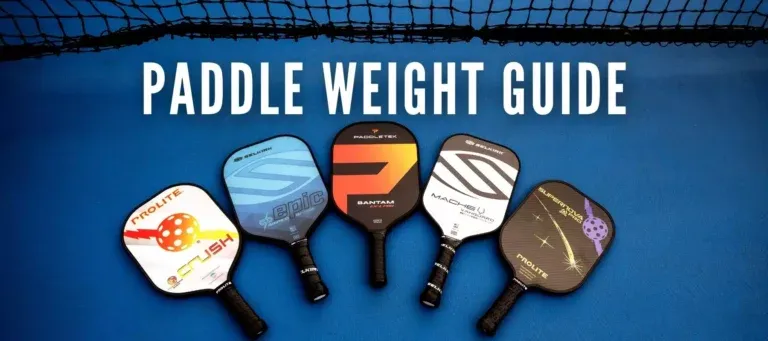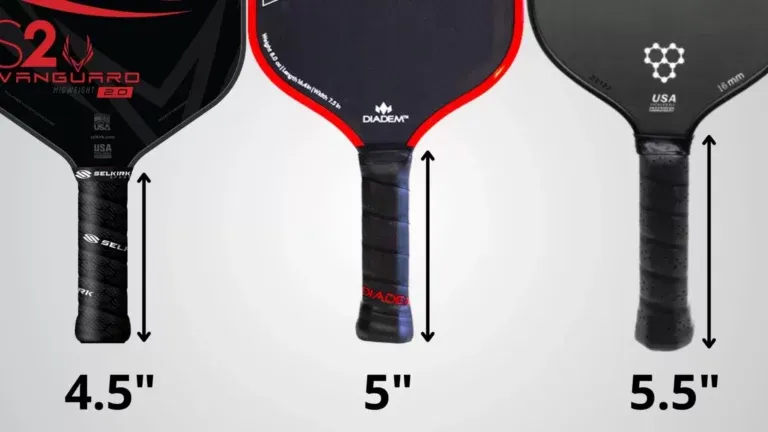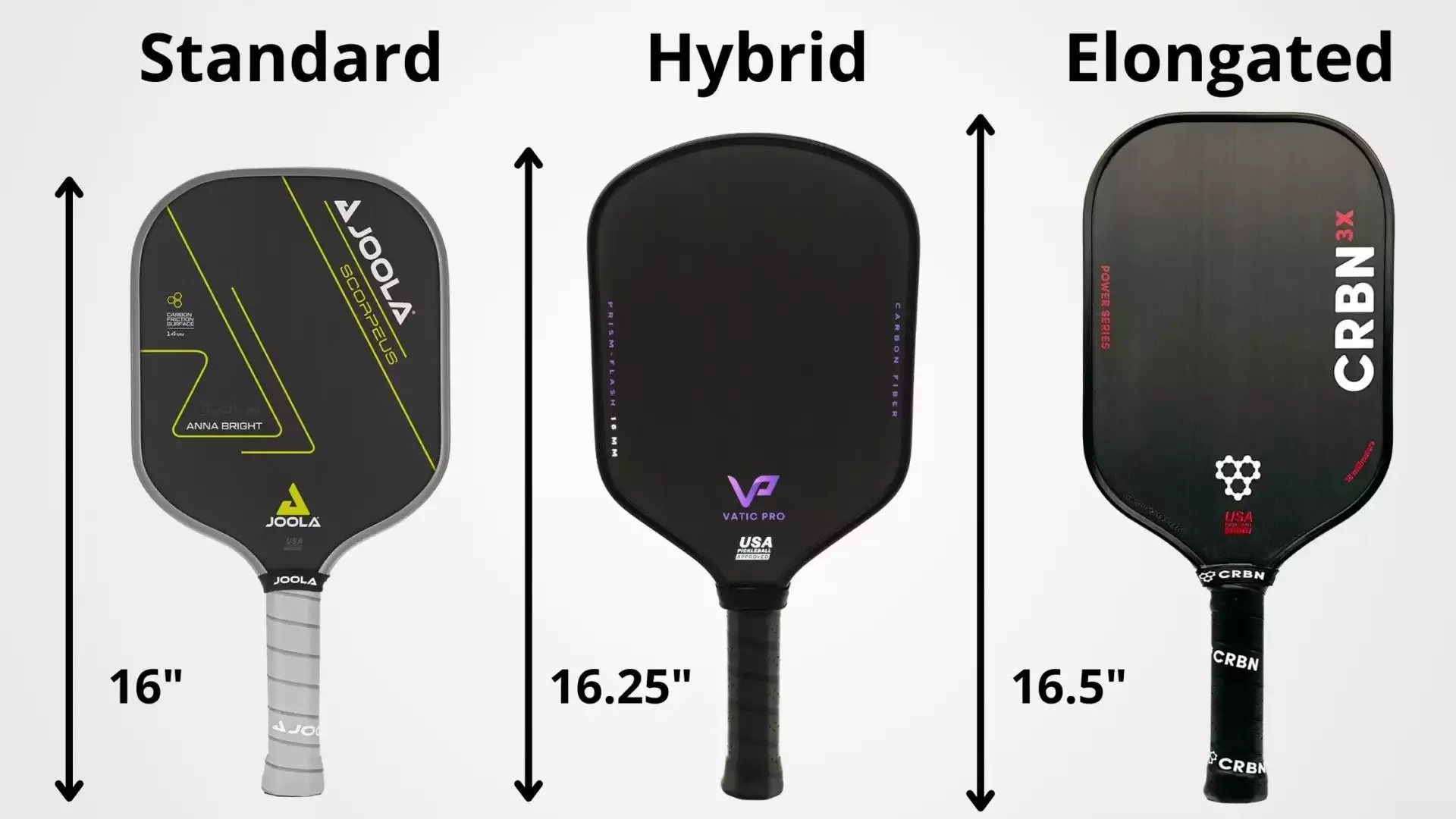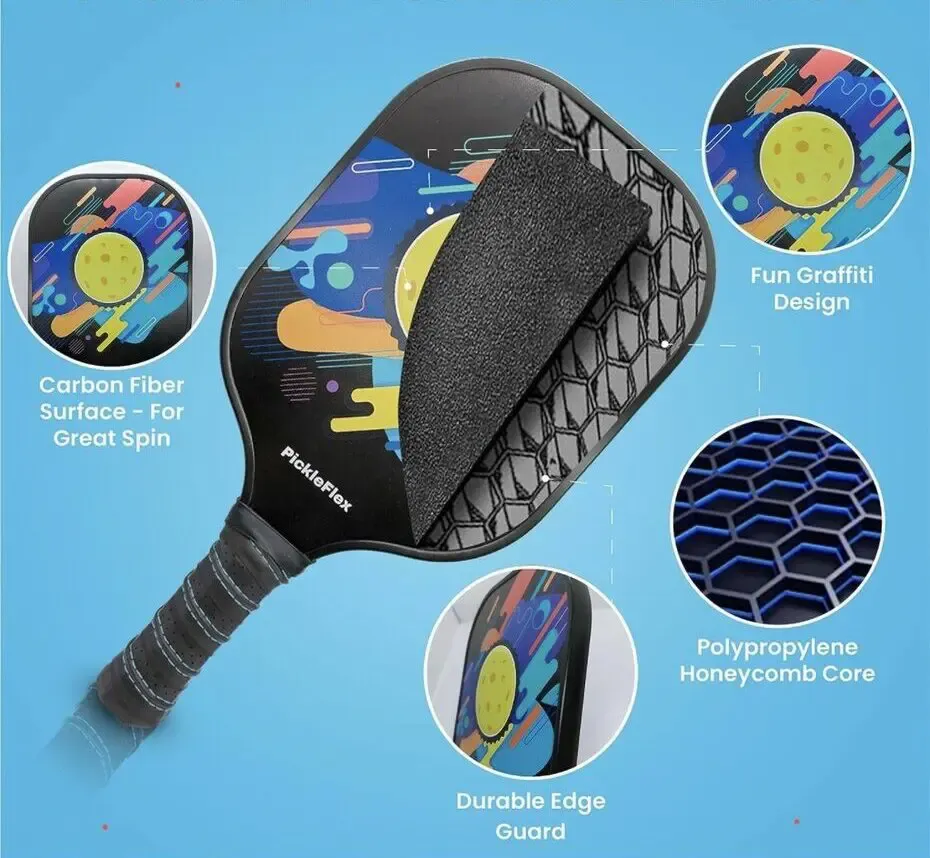Top 5 pickleball paddle recommendations for kids
The search for the top pickleball paddles involves examining various attributes to ensure a good match. Considering factors such as weight, grip size, and material leads to a comfortable choice that fosters skill development. Let's look at some top paddle recommendations tailored for young players that embody these qualities and offer great value.
Best Overall: JoncAye Pickleball Paddle Set for Kids
The JoncAye Pickleball Paddle Set is heralded as one of the top choices for kids. Acclaimed for its well-rounded features, this set brings together performance, durability, and value.
- Complete Set: Included in the JoncAye set are two paddles, four balls, and a carry bag, making it a perfect ready-to-play option for families aiming for compatibility both indoors and outdoors.
- Suitable Weight: Weighing only 8 ounces, the paddles are lightweight, promoting swift maneuvers without exhausting young players. This weight aids in fostering proper technique as it is not a burden on small arms and hands.
- Comfortable Grip: The paddle's 4.25-inch grip circumference comfortably fits in smaller hands, providing the necessary control and comfort crucial for developing players.
- USAPA Approved: Ensuring quality and compliance, the JoncAye set is USAPA-approved, setting kids up for potential competitive play with recognized standards.
- Thoughtful Construction: The paddles feature a fiberglass face, offering a robust combination of power and control. Durability coupled with a responsive feel provides young players with an advantageous playing experience.
Best for Under 12: Helium Pickleball Paddle for Kids
The Helium Pickleball Paddle is specifically engineered for young players under 12, focusing on lightweight handling and a smaller grip to enhance playability.
- Light as Air: This paddle weighs just 6 ounces, truly living up to its namesake by offering children easy handling and rapid reaction time on the court without the fatigue associated with heavier paddles.
- Perfect Fit: Designed with a 3.14-inch grip size, it provides young players with the comfort and control required to master their shots, encouraging proper form and reducing slip accidents.
- Advanced Material: Using a graphite surface and a honeycomb polymer core, the paddle delivers an optimal blend of power and control, incorporating the best of both worlds in weight and performance.
- Starter Friendly: Ideal for beginners, the Helium paddle's design supports skill building through enhancing confidence and minimizing strain, making it an excellent introduction to pickleball.
Best Lightweight: JOOLA Journey Pickleball Paddle
When considering lightweight paddles, the JOOLA Journey Pickleball Paddle stands out, offering a unique combination of lightweight materials and robust performance.
- Effortless Maneuvering: Weighing approximately 7.78 ounces, this paddle combines low weight with agile movement, facilitating quick reaction times for young players who need to move swiftly during play.
- Comfortable Control: With a smaller grip circumference, it’s tailored for young hands, offering comfort and reducing fatigue during extended gameplay sessions.
- Fiberglass Face: The fiberglass construction ensures excellent energy transfer on impact, allowing young ones to harness more power without sacrificing control, an ideal dual-benefit for skill enhancement.
- Vibration Reduction: Built with a response polymer core, the JOOLA Journey paddle minimizes vibrational stress, allowing young players to focus on form and shot execution.
Best Budget-Friendly: XS XSPAK Pickleball Paddles Set
The XS XSPAK Pickleball Paddles Set is a top contender for those seeking value without sacrificing quality. Priced affordably, it offers a complete package that introduces young players to the game effectively.
- All-Inclusive Package: This set includes everything needed to start playing: two paddles, four balls, and an attractive carry bag, making play and transport convenient and straightforward.
- Durable and Affordable: Priced under $75, the paddles boast a construction from T-700 Raw carbon fiber, providing durability typically seen in higher priced models.
- Child-Friendly Weight: With a weight range of 7.9 to 8.1 ounces, the paddles are easy for children to handle, making them ideal for beginners learning the game.
Best for Future Pros: Helium Versus Pickleball Paddle Set
For children showing promise and intent to elevate their game, the Helium Versus Pickleball Paddle Set offers features that support a higher level of play.
- Elite Performance: Crafted from composite materials, these paddles offer the right mix of power and control, enabling more advanced play tailored for those looking to improve significantly.
- Lightweight Dynamics: Offering a lightweight design, these paddles facilitate faster reaction speeds and maneuverability, pivotal for competitive play.
- Exceptional Spin and Control: The paddle face allows for excellent spin capabilities, integral for young aspiring athletes aiming to master diverse shot tactics.
- Durable Construction: Built to withstand rigorous play, these paddles ensure long-lasting use, offering both immediate and future-proof performance for budding sports enthusiasts.
Why choosing the right pickleball paddle matters for kids
For parents and guardians, choosing the right pickleball paddle for young ones is akin to setting the foundation for their sporting future. Weight, grip size, and material are not just features but crucial components that influence a child’s ability to learn and grow in the sport. Getting the selection right means the difference between fostering a lifelong love for pickleball and a feeling of early frustration.
- Weight: A light paddle ensures kids can swing with ease and reduces the risk of arm fatigue. Paddles weighing 6 to 7.5 ounces are ideal, providing a balance between maneuverability and control.
- Grip Size: For children, a smaller grip size helps maintain control and prevents slips. Typically, a grip circumference of around 4 inches is optimal for young hands, providing comfort and security during play.
- Material: The choice of material, such as polymer cores and carbon fiber faces, contributes to the paddle's performance. These materials offer durability and a larger sweet spot, enabling children to hit with consistency and confidence.
- Design and Style: Visual appeal is important for kids. Paddles that come in vibrant colors and attractive patterns can motivate children to play more often, giving them a sense of pride over their equipment.
- Skill Enhancement: Choosing the right equipment impacts how quickly kids can pick up the game. The right paddle boosts their confidence, enabling them to focus on improving their skills instead of struggling with incompatible gear.
See more: Best Pickleball Paddles for Seniors: Top 8 Choices for Optimal Play
Key factors to consider when choosing a pickleball paddle for kids
Choosing the perfect paddle for a young pickleball enthusiast is more than just picking one off the shelf. Numerous factors like weight, grip size, and material matter. These elements are pivotal in shaping a child's ability to maneuver the paddle efficiently. Ensuring the paddle suits their physical build and skill level promotes better play, minimizes fatigue, and ultimately aids in their enjoyment of the game. The subsequent sections will delve deeper into these aspects, providing insight into what you should really focus on.
Weight
When it comes to selecting a pickleball paddle for kids, the first thing that needs consideration is the paddle's weight. The weight directly affects a child's ability to swing and control the paddle. Heavier paddles can be unwieldy for children, leading to fatigue and even injuries.

- Lightweight Advantage: For young players, it's recommended to opt for paddles weighing between 6 to 7.5 ounces. This weight category ensures that the paddle is light enough for children to swing with ease while maintaining enough heft to provide power during hits.
- Balance of Control and Power: In the realm of lightweight paddles, finding the sweet spot between control and power is key. A paddle that is too light might not give the necessary power, while a slightly heavier paddle within the lightweight range can help in returning strong shots without compromising on control.
- Material Contribution: The materials used often influence weight. For instance, paddles with polymer cores or composite materials tend to be on the lighter side. These compounds ensure that the paddle remains durable while being manageable for younger players.
- Benefit for Beginners: Lightweight paddles are especially beneficial for beginners who are still mastering their swing technique. Using light paddles, children can focus on form, endurance, and skills improvement without worrying about the paddle's heft hindering their game.
Grip Size
Grip size is another crucial factor to consider when selecting a pickleball paddle for kids. Getting the grip size right ensures that children can hold onto the paddle steadily, without straining their wrists or losing control during play.

- Perfect Fit: For children, a grip size of approximately 4 inches in circumference is typically recommended. This size tends to fit younger players' smaller hands comfortably, allowing for a secure and firm grip.
- Control and Comfort: A well-sized grip promotes comfort and control, two aspects that are pivotal when young players are still learning to control the ball and maneuver the paddle effectively. It ensures that the child won’t over-grip or grip too loosely, which can lead to slips and arm fatigue.
- Adjustable Grips: Some paddles come with customizable grip sizes, allowing adjustments to suit different hand sizes. This flexibility can be a boon for growing children, who might need a slightly larger grip as they age.
- Avoiding Injuries: Proper grip sizes can help prevent wrist injuries. A paddle that’s too large will require more strength to maneuver, potentially straining a young player's wrist and arm muscles.
Paddle Size and Shape
The size and shape of a pickleball paddle can significantly influence a child's gameplay and enjoyment. These elements determine the paddle's reach, power zones, and forgiveness on off-center hits.

- Wide vs. Elongated: Standard or wide-body paddles are ideal for kids as they offer a larger sweet spot, providing forgiveness and ease for players still mastering their precision. Elongated paddles, while offering more reach, can be less forgiving and harder to control for younger players.
- Proportionate Size: The overall length and width should suit the child's height and arm length. Ensuring the paddle proportions are right helps the child manage shots without exerting unnecessary effort, aiding both skill development and comfort.
- Optimizing Play: A child-sized paddle often strikes the right balance between power potential and agility. With these paddles, children can focus on learning technique rather than compensating for cumbersome equipment.
- Beginner Friendliness: For beginners, a paddle that is wider provides an expanded sweet spot, reducing errors and boosting confidence. When children are not constantly worried about missing shots, they can focus on skill improvement and enjoying the game.
Paddle Material
Material choice in a pickleball paddle is not just about durability; it greatly affects the performance and feel of the paddle. Here's what to keep in mind when choosing the material for a child's paddle.

- Polymer Cores: For young players, paddles with polymer honeycomb cores are often optimal. They provide a soft feel, which is easier on younger wrists and offers a balance of power and control essential for developing skills.
- Composite Construction: These paddles combine different materials like fiberglass and carbon fiber, offering a middle ground between the heavier wood paddles and the high-end graphite options. Their lightweight structure is easier for kids to manage while retaining durability.
- Durability vs. Cost: Material influences not just performance but cost. Composite materials can be more affordable than graphite while still providing good performance and durability. For children new to the game, starting with a composite paddle is a wise and economical choice.
- Advanced Materials: More advanced materials, like carbon fiber, can be an option for older children transitioning into competitive play. These materials provide superior control and touch, but may not be necessary or cost-effective for very young or new players.
Design and Appearance
Paddles designed for children often incorporate fun and colorful designs, adding an element of enjoyment to the game. While performance and comfort of the paddle are paramount, the appearance shouldn't be overlooked.
- Child-appealing Designs: Vibrant colors and playful graphics can increase a child's eagerness to play. Paddles that feature favorite characters or bright colors are more likely to appeal to a young player's taste and encourage them to pick up the game regularly.
- Personal Style: Allowing kids to choose a paddle based on its design can give them a sense of ownership and pride in their equipment, which can translate into more enthusiasm on the court.
- Attractive Branding: Established brands often feature famous players or recognizable logos on their paddles, which can be motivational for aspiring players who look up to these athletic icons.
- Complementary Gear: Matching accessories, like color-coordinated paddles and grips, add to the fun. This holistic approach to sporting goods can inspire kids to engage in more frequent play when they feel connected to their gear.
Budget
Budget plays a significant role in determining which pickleball paddle to purchase, especially when considering that children's interests may change over time.
- Entry-Level Costs: For beginners, more affordable options are available that do not compromise on fundamental aspects such as weight and grip size. Budget-friendly paddles are perfect for initial learning and when the child is just exploring the sport.
- Value Packages: Many budget options come in sets that include multiple paddles and balls, providing great value for family play or when trying out the sport in groups.
- Investment vs. Interest: Parents must weigh the cost against the level of interest their child has in pickleball. While purchasing high-end paddles might not be cost-effective for an uncertain interest, spending a small amount on a quality starter paddle can be a good balance.
- Durability: It's important to consider durability within budget paddles. Opting for a paddle with durable materials ensures longer usage and an extended learning period without needing regular replacements.
Intended Play Frequency and Skill Level
The frequency of play and the skill level of the child greatly inform the choice of a pickleball paddle.
- Casual vs. Frequent Play: For children who only play occasionally, a basic, budget-friendly paddle will suffice. These paddles offer the essential features necessary for enjoyment without a significant investment.
- Developing Skills: For those more committed to the sport, investing in a paddle designed for skill development can be beneficial. These are typically made with higher-quality materials that enhance control and precision.
- Skill-Based Choices: A child's current skill level should guide the paddle choice. Beginners benefit from paddles with an extended sweet spot and lighter weight, while intermediates might desire more advanced materials that allow for nuanced gameplay.
- Progressive Investment: As kids improve, transitioning them to more advanced paddles can sustain their interest and skill growth, allowing them to tackle more complex aspects of the game and perhaps compete in organized play.
USAPA Approval
USAPA (USA Pickleball Association) approval is essential for many aspiring young players, especially those interested in competitive play.
- Competitive Standards: A USAPA-approved paddle assures compliance with standards for competitive play. This certification is crucial for children who may compete in tournaments or organized leagues.
- Quality Assurance: The certification offers parents reassurance that the paddle meets recognized quality and performance criteria in terms of construction and playability.
- Future-Proofing: Choosing an approved paddle prepares children for organized play if their interest extends beyond casual games, ensuring they won't need an equipment upgrade when joining a league.
- Focus on Play: Knowing the paddle is certified can give young athletes confidence, allowing them to focus on improving their game rather than second-guessing their gear choice.
- Strategic Design: Features like spin-friendly faces and a 4-inch grip size foster skill development in control and technique, encouraging young players to refine their game.
Considering the transition to adult paddles
When contemplating the transition from kids' to adult paddles, several factors come into play. Transitioning wisely ensures a smooth adaptation without compromising performance or increasing health risks.
- Appropriate Timing: This shift should be driven by the child’s growth in physical stature and skill level. An adult paddle’s larger size is manageable if the child's grip matches adult parameters - notably, a grip size average of 4¼ inches.
- Weight and Material Adjustments: Adult paddles are heavier, which might initially be inconvenient but are essential for developing greater power. Encouraging young athletes to adjust to this weight when age-appropriate promotes enhanced strength and control.
- Skill Compatibility: Kids comfortable and proficient with a child's paddle might be ready for adult paddles when they require greater reach and power while maintaining control, characteristics found in adult-sized paddles.
- Economic Consideration: Investing in an adult paddle may initially seem costly but offers longevity with the growth of the child’s playing style and seriousness toward competitive play.
- Gradual Transition: Employing a phased approach can help. Start utilizing adult paddles in practice to acclimate to the new weight and size before using them in games, ensuring the change feels natural and advantageous.
Safety, maintenance, and care for kids' pickleball paddles
Transitioning to adult paddles entails a need for awareness regarding safety and proper maintenance, as the equipment tends to have specific care requirements due to varied materials and designs.
- Ensure Safety First: Always focus on making sure the paddle fits the child properly and enhances safe play. This prevents injuries and promotes a healthy sporting environment.
- Supportive Maintenance: Essential for paddle longevity, maintaining equipment translates into consistent performance. Techniques such as cleaning after each use and proper storage practice prevent premature wear and tear.
- Routine Checking: Regular inspection for any signs of damage, like cracks or grip issues, ensures swift correction; this foundational care secures both the safety and performance of the paddles over time.
Safety Considerations
Safety is an imperative aspect of pickleball that shouldn't be taken lightly, particularly for young players. Ensuring the chosen paddle adheres to safety standards is key.
- Proper Size and Fit: Selecting paddles in accordance with a child’s grip size and playing capabilities prevents strain-related injuries avoiding unnecessary discomfort.
- Safety Gear: Encourage kids to wear protective gear such as wrist guards and proper shoes; this extra measure can also aid in safeguarding against various on-court mishaps.
- Paddle Condition: Keep paddles in top condition by regularly checking for chips or cracks. Playing with damaged paddles can lead to serious accidents if untreated.
- Skill-appropriate Play: Ensure the child’s play matches their skill level; starting with basic techniques before advancing supports safety by minimizing overexertion or risky play attempts.
Maintenance and Care
Consistent maintenance and care of paddles ensure they remain functional and efficient for young players.
- Regular Cleaning: After every use, paddles should be wiped clean with mild soap and a soft cloth to eradicate grime and sweat that accumulates during gameplay.
- Appropriate Storage: Store paddles in a cool, dry place away from extreme heat or humidity. This process prevents warping and material degradation ensuring a longer lifespan.
- Protection: Encourage using paddle covers, which shield them from scratches or accidental impacts during transit and when not in use.
- Periodic Checkup: Every so often, inspect paddles closely for signs of wear or damage, replacing any elements such as worn grips, ensuring consistent performance.
Conclusion
In the world of pickleball, selecting the right paddle for kids is a cornerstone to nurturing their love for the game. By prioritizing factors such as weight, grip size, and material, parents can provide their children with the best opportunity to enjoy the sport while developing their skills effectively. Additionally, embracing design elements and budget considerations ensures that a child's interest is maintained and their progression supported. As they grow, transitioning to adult paddles becomes seamless, supported by safety practices and diligent maintenance routines. Ultimately, this informed choice fosters an enduring connection to pickleball, setting the stage for both enjoyment and achievement within the sport.
FAQs
Having navigated through various aspects of selecting a pickleball paddle, understanding common queries can further refine the decision-making process, ensuring informed and precise choices.
Can my child just use my old adult pickleball paddle?
While it might be tempting to allow your child to use your old adult pickleball paddle, it may not be the best option for nurturing their skills. Adult paddles have grips designed for larger hands, usually averaging a circumference of around 4¼ inches. On the contrary, kids are better suited with junior paddles that offer smaller grips, commonly around 3.5 to 4 inches, which fit their hands better and encourage proper control and technique. Using an adult paddle can hinder their performance and possibly discourage their enjoyment of the sport due to its unsuitable grip size and increased weight, which aren't ideal for their developing muscles.
What is a typical "junior grip" size?
A "junior grip" size is tailored to fit the smaller hands of young players. Generally, it is designed to be between 3.5 to 4 inches in circumference. This size allows children to hold the paddle firmly and comfortably without strains. Maintaining this grip size ensures optimal control of the paddle, which is essential for developing consistency and confidence in their gameplay. It’s a significant departure from adult grips, which start at 4 inches and can reach up to 4¾ inches for larger hands. Picking a paddle with a junior grip enables young players to develop and refine their technique effectively, avoiding the pitfalls of struggling with an oversized handle.
What are the 3 most important things to look for in a paddle for a young child (under 10)?
When choosing a pickleball paddle for a young child, focus on the following essential elements:
- Weight: Light paddles, which range between 6 to 8 ounces, are recommended. They provide ease of use and reduce the risk of arm fatigue, enabling children to focus on learning proper techniques without overexertion.
- Grip Size: Comfort and control are paramount. A grip size of around 3.5 to 4 inches serves young players well, allowing for a secure hold, which is crucial for developing skills and preventing slips.
- Material: Opt for materials that balance durability and ease of play. While wood paddles are budget-friendly, composite or lightweight polymer paddles are recommended as skill levels advance. They afford more manageable handling and a larger sweet spot, favorable for skill progression.
Are wood paddles okay for kids to start with?
Wood paddles can indeed serve as a starting point for young players introducing themselves to pickleball. They are generally budget-friendly and provide a robust introduction to paddle handling, allowing kids to make initial contact with the sport without a significant financial outlay. However, due to their weight often greater than lighter composite options wood paddles might be challenging for prolonged use and sophisticated play. Transitioning to lighter composite paddles as children progress will enhance their playability and enjoyment, reducing the physical demands wood paddles impose while fostering better technique and responsiveness.




















